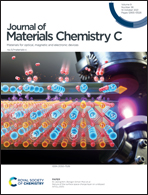Conductive thermoplastic polyurethane nanocomposite foams derived from a cellulose/MWCNTs aerogel framework: simultaneous enhancement of piezoresistance, strength, and endurance†
Abstract
The high conductivity and excellent mechanical properties of polymer composites favor their application as piezoresistive strain sensors. However, developing polymer composites with desirable piezoresistance, mechanical and durable properties is challenging. Herein, we developed conductive cellulose/MWCNTs aerogels using the freeze-drying technique. Furthermore, we explored the application of the highly-sensitive piezoresistive polymer composites following supercritical carbon dioxide (ScCO2) foaming, in cellulose/MWCNTs aerogel-thermoplastic polyurethane (TPU) nanocomposites. Conductive polymer composite (CPC) foams exhibited a significantly low percolation threshold (MWCNTs loading of ∼0.07 vol%) and high piezoresistive sensitivity (GF value of 7.84) owing to the low density (∼0.15 g cm−3) of cellulose/MWCNTs, high porosity (90%) and high electric conductivity (2.04 S m−1). The microcellular structure of composite foams was stable with regard to energy loss coefficient and piezoresistance after several compression cycles (1000 cycles). The behavior of the prepared CPC foams under different conditions was evaluated. The findings of the study showed that the piezoresistive sensors can be used in real-time monitoring of human movement.



 Please wait while we load your content...
Please wait while we load your content...